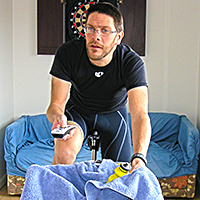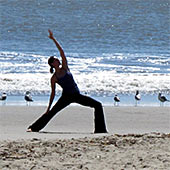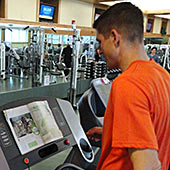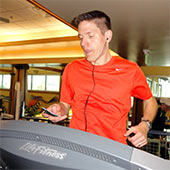How To Stay Motivated
 Most people are excited and motivated to workout when they buy that beautiful new elliptical trainer, home gym or exercise bike. Ditto for a new bicycle or just nice, new running shoes. While this enthusiasm and motivation lasts a while, it's common to lose some of it a few months down the road. This loss of motivation can even affect experienced and accomplished athletes, so you're not alone.
Most people are excited and motivated to workout when they buy that beautiful new elliptical trainer, home gym or exercise bike. Ditto for a new bicycle or just nice, new running shoes. While this enthusiasm and motivation lasts a while, it's common to lose some of it a few months down the road. This loss of motivation can even affect experienced and accomplished athletes, so you're not alone.
Fortunately, there are great ways to maintain your motivation and keep exercising fun. That's what this article is all about. It's full of helpful tools and tips for sustaining your enthusiasm, keeping your workouts fun and establishing a permanent, fit lifestyle.
Goals
We all have reasons we’re inspired to exercise and committing to a fitness regimen. Yet, it's really helpful to carefully consider these reasons and establish one or more goals. Because, while you may successfully exercise for awhile without goals, you’re eventually likely to find yourself wandering. So here’s a helpful, five-step process for goal-setting:
1. Start by establishing a specific, long-term goal. Write it down, share it with supportive friends and family members, and explain why the goal is important to you.
2. Make sure your goal is both healthy and realistic. It’s important that any goal setting requires sustainable changes, instead of a radical transition that you find overwhelming only days or weeks later.
3. Based on your long-term goal, work backward to set up short-term, stepping-stone goals. Your short-term goals should be broken down into simple, detail-oriented action plans.
4. Keep your long-term goals, short-term goals and action plans quantifiable and time sensitive.
5. Track your progress (see Log Your Workouts section), and at the end of the specified time period, review your progress toward your long-term goals, short-term goals and action plans.
As you work toward your fitness goals, you may need to set new goals, reaffirm existing goals, revise your long-term goals or revisit your reasons for initially setting your fitness goals. It's all part of staying focused and sticking with your plan. As you do this, remember to be positive and don't get discouraged. If you're struggling, focus on times in your life when you’ve been successful and recall how consistent efforts have paid off in the past.
In the event you fall short or have difficulty in reaching a fitness goal, keep in mind all of the health and fitness gains you’re making even if you haven't achieved the goal you set. For example, if your goal is to lose a certain amount of weight, and that weight isn’t coming off as quickly as you’d like, consider that you’re simultaneously developing your cardiovascular system, building muscular endurance, bettering your heart health, improving your cholesterol and more.
And, when you do attain a fitness goal, enjoy the pride and satisfaction that comes with such an accomplishment!
Here are more suggestions to help drive your success:
- Promise yourself a healthy reward for achieving a fitness goal. Good examples could include buying new exercise apparel or getting a massage, while a bad example would be celebrating a weight-loss milestone with a trip to an all-you-can-eat restaurant.
- Stay motivated by repeating set workouts on a regular basis to track your progress. A runner or cyclist might choose to measure their performance over an outdoor course or a preset program on a treadmill or exercise bike. For strength training, a good choice could be periodic tests with a series of lifts involving one or more muscle groups. If you’re training consistently and you space these workouts far enough apart, you should be setting yourself up for success with very noticeable progress. Each time you repeat these workouts, it’s important to replicate every possible aspect of the workout to provide easy, fair comparisons.
- Get competitive! A great way to stay motivated and make fitness even more fun is sharing a low-key challenge with someone else that has similar fitness goals as you. Or, enter a race or a charity endurance event to have others to exercise with.
Establish a Routine
To successfully incorporate and maintain fitness as a regular element of your lifestyle, it’s important to establish consistent routines or a workout schedule. If you're having trouble consistently squeezing a workout into your busy day, schedule your workout as an appointment. Treat this fitness appointment as you would an important meeting or a doctor's appointment: write it down, add it to your calendar, put it on your to-do-list, or input it into your smartphone. And, then remember to keep this important appointment with yourself. Your fitness and goals depend on it!
Another tip is to focus on establishing exercise as a daily essential, like sleeping, eating or brushing your teeth. People often speak of not having enough time to exercise. One perspective is looking at each week as 336 half-hour periods, and realizing that you only need to block out a handful of them to maintain a solid level of fitness. That leaves a lot of time to sleep, work, care for your family and much more. It's far more important for your workouts to be consistent than it is for them to be long or difficult.
There has been much discussion and research about the best time of day to exercise, and depending on the type of exercise, there may well be a time period during each day when your body can deliver a peak performance. Circadian rhythms, hormone levels, blood pressure, body temperature, energy levels and a number of other factors all play a role here.
You may do well by waking up every morning at the same time for your daily workout. In fact, studies have shown that people who work out in the morning are more likely to continue their exercise routine. The morning can provide cooler temperatures and an empty stomach, both helpful for cardio workouts. Often, as the day progresses, your exercise consistency can be threatened by fatigue, a hard day of work and/or family obligations, a stressful commute or a full stomach.
 On the other hand, a workout may help you unwind from the stresses of the day and lead to a more relaxing evening. Plus, some people simply don’t do well in the morning, and they may find that a lunchtime, late afternoon or evening workout suits them better. Weather can play a role with workout scheduling, as can the availability of a workout partner. Some parents develop consistency by always working out immediately after dropping off their kids at the school or bus stop.
On the other hand, a workout may help you unwind from the stresses of the day and lead to a more relaxing evening. Plus, some people simply don’t do well in the morning, and they may find that a lunchtime, late afternoon or evening workout suits them better. Weather can play a role with workout scheduling, as can the availability of a workout partner. Some parents develop consistency by always working out immediately after dropping off their kids at the school or bus stop.
Ultimately, the best time of day comes down to what logistically works best for you and keeps you exercising consistently.
Commit to tomorrow's workout by setting out your workout clothing (and any other gear you might need) before you go to sleep. It may seem like a small matter, but being ready to go eliminates one potential roadblock in the way of your morning workout.
Do you ever wake up and feel too tired to exercise? When you wake up and the warm bed threatens to win out over a run outside or on the treadmill, get up and commit to running for 15 minutes before making the final decision to keep going for a full-length workout. This creates a win-win situation, as more often than not, you'll feel fine once you get going, and you'll have no problem continuing with your normal workout. If you still feel tired and decide to stop, you'll have kept up your morning routine, done more than nothing, and established an exercise precedent to keep an exercise appointment with yourself.
Or, if you finish your work day, feel beaten down, and dinner or happy hour beckons, always have an option for a backup plan workout. If you have an up-tempo cardio effort or heavy weight-training session planned, and know that you're not physically or mentally up for it, take an extra easy day before your planned hard workout instead of scrapping your exercise altogether. Again, consistency is the key theme here. Plus, you'll likely be more rested and recovered for the higher-intensity workout you still have planned.
If illness or low energy results in a missed workout, don't beat yourself up! And don't feel as if you've ruined your entire week of workouts. It's only one workout! The key here is to focus on completing your next workout and maintaining consistency going forward. Get back in touch with your goals and remember why you're working so hard to begin with. Read your workout log and remind yourself how regularly you've been exercising.
And, Then… Change Things Up  While developing a consistent workout routine is essential, make sure you keep your workouts fresh and interesting. If you do the same workout every day, your workout routine will quickly become monotonous and not as effective. The sky’s the limit for introducing new elements to an established workout regimen:
While developing a consistent workout routine is essential, make sure you keep your workouts fresh and interesting. If you do the same workout every day, your workout routine will quickly become monotonous and not as effective. The sky’s the limit for introducing new elements to an established workout regimen:
- Experiment with a new preset program on your treadmill, elliptical or other indoor fitness machine. Many indoor exercisers get stuck with the quick start or manual programs and would benefit from trying out a hill program, interval session or random course.
- For workouts outside your home, explore new territory on your bike, hike or run on a new trail, or work out at a different gym. Any workout locale can become boring after enough workouts in the same place, so some fresh scenery can help jumpstart a workout routine gone stale.
- Add one or more new strength exercises to your current lifting regimen. Learning a new way to work a muscle or muscle group adds variety to your workout and helps you make strength or size gains.
- If you currently do all of your strength training on machines, add some free-weight exercises, fitness-ball training or floor work to mix things up and enhance your functional fitness.
- For endurance activities and sports, go longer, shorter, faster or easier. It’s easy to fall into a regular routine of similarly paced workouts of similar lengths, so instead of 2 medium-length workouts, try a longer training session followed the next day by a shorter workout. Or follow the same pattern with an up-tempo workout followed by an easy day. Experiment with making your higher-intensity workouts harder and your recovery days easier.
- Don’t get bored with the only home fitness equipment you have. When you can, add a new machine to give you a whole new workout and cross-training option. If you already have a solid, weight-bearing, cardio machine (treadmill, elliptical trainer, stepper, etc.), you may really enjoy and benefit from a seated workout offered by an exercise bike or rowing machine. You can supplement your home-gym strength training with free weights and a bench. Or make smaller, but effective, changes by adding fitness tools like rubberized tubing, a medicine ball, or a fitness ball.
- Learn a new athletic/recreational skill or get better at an old one. Learn cross country skiing or ice skating, take a swim lesson or yoga class, or try out a dance class with your significant other. You may find a new sport you enjoy or simply feel energized from sampling a fresh activity.
- Does your typical strength training session consist of traditional free weights (dumbbells and/or barbells)? Bring home some kettle bells for some full-body, functional training. Learn more about how to use them with a training guide and/or DVD, or take a kettle bell class for hands-on training. Another option is performing dumbbell exercises while standing on a BOSU Trainer, balance disk or balance pad for a combination of weight training, balance work and core strength.
- Incorporate some aerobic exercise into your routine if you’re currently focused solely on strength training. Likewise, add strength training to the mix if your workout regimen only includes aerobic exercise.
- Add flexibility tools like a stretching strap, a foam roller or an inversion table. Improving or maintaining flexibility is a crucial, if often-overlooked, component in a successful fitness lifestyle. And, the regular addition of stretching can enhance your health and the effectiveness of all of your workouts.
Log Your Workouts
Just as it’s great to establish goals and write them down, it’s super helpful to log your workouts and any other information that you deem important to your success. And, it’s motivating to keep this workout log readily accessible or visible. Popular choices include computer spreadsheets, charts hung on the refrigerator, or a notebook you can take with you. Or, you might want to keep an online workout log for access from any Internet-connected device, or even make a more public record of your progress by maintaining a blog.
Ideally, you’ll choose a method that lets you readily update your workout log and regularly update your progress. Some people keep it simple with objective data and others use their log as a daily journal. The following lists include several possibilities of what you could track in your workout log:
| Cardio Workout Data | Strength Workout Data | Non-Workout Data |
|
|
|
Lots of people log their workouts and stop there. Instead, we recommend reading your workout log. The positive reinforcement that can be found in your simple workout log is potentially monumental for your motivation. Go back and read what your workouts were like when you started. Compare the quantitative results of early workouts to more recent, identical workouts. Give yourself credit for the work you’ve done.
Keep it Fun and Social!
Have fun with being active! One reason that many people’s health and fitness levels decline as they age is that they stop playing! It’s important for you to find ways to sometimes take the work out of your workout and enjoy fun ways to increase your activity level. And, when possible, seek out ways to exercise or recreate with others.
Organize a neighborhood game of Capture the Flag at a local park, throw a Frisbee around with friends or family, or play croquet in your yard with your kids. Recreating casually with others is a great way to boost your movement and improve your fitness without having to be motivated for a structured workout. Other ideas for social recreation include getting out for a moonlight hike with a group, joining a sports league, or running along with your child as they ride their bike.
Look for ways to share an indoor workout with a friend or family member. Feel good about getting others involved, modeling a healthy, fit lifestyle and having fun staying fit. Or, look for a workout partner for indoor or outdoor workouts. Enjoy the mutual journey, battle the elements together, pass the time with good conversation, and enjoy the camaraderie and shared effort. Also, most people are unlikely to skip a workout if it means standing up a friend who’s expecting you.
 Invite your neighbors to join you for a workout, or even start a neighborhood club for walking, hiking, running, cycling or whatever outdoor activity interests you. Social recreation can provide additional accountability and an enjoyable reason to exercise.
Invite your neighbors to join you for a workout, or even start a neighborhood club for walking, hiking, running, cycling or whatever outdoor activity interests you. Social recreation can provide additional accountability and an enjoyable reason to exercise.
While traditional fitness workouts may make up the bulk of your activity, finding ways to keep it fun, increase your activity level and seek out recreational opportunities with others can go a long way toward keeping you motivated and reaching your goals.
A Comfortable Indoor Environment
When trying to sustain an indoor exercise routine, it’s important to make the experience as enjoyable as possible. The first step is making sure you have high-quality fitness equipment that feels comfortable. At that point, it’s crucial to find the best possible location for your fitness equipment. While an outdoor workout potentially presents varied scenery or terrain, and a recreation center or health club offers social interaction, the success of your home workout environment can depend largely on the comfort of your workout space and the entertainment options available to you.
Consider what you’re looking for in a workout space. For example, if you’re looking for a more inviting space that lets you be closer to your family or roommates, you may want to place your fitness equipment in a living area. Or, if you’re in need of a space where you can escape to exercise at any time without waking up others, a basement may be a better option.
As you may have limited options on where to put your fitness equipment, it’s important to make the best out of any space you have available. The following elements can greatly enhance a potential workout space:
- A well-placed television lets you keep up with your favorite shows, news programs and sporting events while the workouts fly by. And, a DVR or VCR lets you record shows for commercial-free viewing at any time.
- A window, and a fan can make all the difference in exercising longer and maintaining or increasing your workout intensity, especially when you're using indoor cardiovascular equipment.
- Rubber flooring reduces noise and provides a comfortable, slip-proof surface for cardio equipment, home gyms, benches and floor exercises. If rubber flooring isn’t feasible, carpeting can make a room feel more inviting while providing a comfortable surface for stretching, and individual rubber mats can be placed under benches or machines.
- Mirrors are great for monitoring your form during strength training, indoor cycling or treadmill running.
- And, a fun tip is to try different wall colors to make your exercise space feel more inviting or add energy.
Indoor Entertainment and Distractions  One of the best way to succeed in all your indoor workouts is by staying entertained. Entertainment lowers the mental energy required to start and complete a workout, and can be a big help toward extending the length of your exercise sessions and enhancing the quality of your workouts too.
One of the best way to succeed in all your indoor workouts is by staying entertained. Entertainment lowers the mental energy required to start and complete a workout, and can be a big help toward extending the length of your exercise sessions and enhancing the quality of your workouts too.
Just knowing that you can watch one of your favorite television shows while exercising is a huge motivator to start your workout. Do you have a long treadmill run, extended elliptical jaunt or lengthy exercise bike ride planned? Watch a movie to help you get through the workout.
Get lost with a good book or interesting magazine and the time will fly by during a cardio workout. And, if trying to hold or focus on reading material while working out isn’t your thing, try listening to audio books. Or, while you build aerobic endurance, you can also learn a foreign language with audio language-learning CDs.
And, whether you’re engaged in a strength or cardio workout, music can boost the intensity of your efforts. An iPod or MP3 player lets you keep the music to yourself if needed too.
Some exercisers find that talking on the phone during easy indoor workouts makes the time fly by. As long as you can talk comfortably (a headset is recommended) and the conversation doesn’t impede your workout, this technique lets you catch up with friends or family while offering a welcome distraction from a repetitive exercise session.
Television and music can also be used to actually inspire the structure of cardio workouts. Try one or more of the following ideas or create your own:
Treadmill Commercial Break
Using the speed and/or incline controls, run or walk at a moderate/hard intensity. At each commercial break, lower the intensity to an easy/recovery level, and then resume the moderate/hard intensity when the show returns.
Elliptical Football
While watching a football game, pedal forward while your favorite team has the ball, and pedal backward while the opponent has it. Increase the intensity (speed up or increase the resistance) while the ball's in play, and back off the intensity between plays. If you’ve been using the moving upper-body handles throughout the workout, switch to lower-body-only mode during commercials. If your elliptical includes an incline function, increase the incline each time your favorite team scores and decrease the incline each time the opponent scores.
Random Rowing
Load a variety of music on your iPod/MP3 player, and set it to shuffle play. Row at a high intensity during upbeat tracks and a low intensity during slower songs. The random aspect of the shuffle play creates a fun, unpredictable aspect to the workout.
Basketball Biking
While riding an indoor cycling bike and watching a basketball game, ride at a moderate intensity. When your favorite team has the ball, stand up to ride out of the saddle and pedal hard. While the opponent has the ball, sit down and return to the moderate intensity. Ride easily during breaks in the action (time-outs, free-throws, halftime and commercials).
Even with several entertainment options available, you may still find yourself constantly staring at your cardio machine’s console, wondering if the workout will ever end. A simple solution is to cut out a lightweight piece of cardboard to place over the console’s display. Attach this temporary cover with Velcro and cut holes in the cardboard for data displays you need to watch or controls you need to access.
 If you have trouble choosing what workout to do, transform a board-game spinner into a Dial-A-Workout Spinner. If you have one machine, list several potential workouts for that one machine, and let the spinner determine what workout to perform on a given day. With more than one machine, include multiple workouts for each machine. If you don’t have a spinner, write down a list of 6 workouts and roll a die to determine which workout to perform.
If you have trouble choosing what workout to do, transform a board-game spinner into a Dial-A-Workout Spinner. If you have one machine, list several potential workouts for that one machine, and let the spinner determine what workout to perform on a given day. With more than one machine, include multiple workouts for each machine. If you don’t have a spinner, write down a list of 6 workouts and roll a die to determine which workout to perform.
For long-term motivation with your aerobic workouts, hang a map in your indoor workout space and choose somewhere you’d like to visit. Mark the location on a map and track every workout’s distance over a period of weeks or months until you “reach” your destination. A nice twist is to reward yourself for your consistent efforts with an actual trip to your vacation spot!
Other Helpful Ideas
If you find your motivation waning, here are a few more suggestions:
- Get fueled! Whether it’s a morning run on the treadmill, a mid-day ride or a post-work strength session, your body needs fluids and energy from food to perform at its best. And, without this sustenance, your lower energy levels may reduce your motivation for quality exercise and an extended workout. Experiment with which easily digested foods and drinks work best for you before and during exercise. If you’ll be exercising for an extended period of time, make sure to have easily accessed food and fluids with you. And, especially with longer or higher-intensity workouts, don’t forget to get a jump-start on recovery by quickly replenishing your fluids, carbohydrates and proteins with a balanced, post-workout snack or meal.
- Sleep more!. Sleep deprivation has been strongly linked to overeating, weight gain, fat metabolism problems and hormonal imbalances.
- Are you new to fitness, chasing athletic goals, or looking to gain fitness experience and knowledge? Consider hiring a personal trainer or a coach. A personal trainer can design a personalized workout plan, teach you how to properly perform strength and stability exercises, and help steer you toward your goals. Similarly, coaches offer sport-specific, personalized training plans, guide you through workouts, and help you stay on track in pursuit of your goals.
- Walk or run with your dog. This type of activity is a win-win, as you and your dog will benefit from the increased activity level. Don’t have a dog? Borrow a neighbor’s dog (seriously!) that doesn’t get out enough or volunteer to help walk dogs at a local animal shelter.
- Pick up a new book to learn new exercises for dumbbells, kettlebells, rubberized/elastic tubing, medicine balls, balance tools and more. Check with us for book ideas.
While it’s important to embrace a sustainable fitness program, don’t be overwhelmed by the enormity of maintaining a workout regimen for the rest of your life. Find the motivation to start and complete today’s workout, while leaving tomorrow’s workout for tomorrow. Enjoy the journey!
